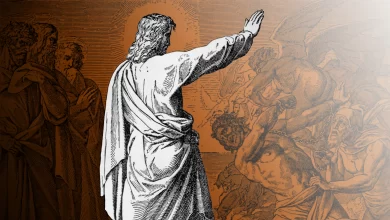Isaiah 53 cannot refer to Jesus because it says the servant of the Lord was sickly and died of disease.
Isaiah 53 cannot refer to Jesus because it says the servant of the Lord was sickly and died of disease.
This is the least likely interpretation of the relevant verses in the Hebrew, as confirmed by many major translations, both Jewish and Christian. The text indicates that the servant of the Lord will be a man who is intimately associated with pain, grief, and sickness, a man suffering at the hands of people and crushed by the Lord as a guilt offering on our behalf. Such an understanding of the words is found in some Rabbinic interpretations too.
There are a number of expressions in Isaiah 52:13–53:12 that clearly describe violent acts committed against the servant of the Lord rather than simply describing the servant as sickly. According to 53:5, he was pierced, crushed, and wounded; according to 53:7, he was oppressed and afflicted, led as a lamb to the slaughter; according to 53:8, he was taken away by oppression and judgment.146 This explains what is written in 52:14: “There were many who were appalled at him—his appearance was so disfigured beyond that of any man and his form marred beyond human likeness.” This is also in keeping with the New Testament description of the sufferings of Jesus, as he was beaten, flogged, abused, and mocked before his crucifixion.
Classical Rabbinic commentaries that interpreted Isaiah 53 with reference to Israel’s sufferings also emphasized the violent deaths that the Jewish people have suffered at the hands of their enemies rather than speaking only of sickness and disease (see, e.g., Radak). This too agrees with a Messianic Jewish reading of the text.
What then of the passages that apparently speak of the servant’s own sickness? As rendered in the Orthodox Jewish Stone edition, Isaiah 53:3 reads, “He was despised and isolated from men, a man of pains and accustomed to illness. As one from whom we would hide our faces; he was despised, and we had no regard for him.” This could mean that the servant was sickly to the point of being disfigured and thus rejected. But it could plausibly mean that the servant was hated and misunderstood, totally identified with sick and hurting humanity. The NJPSV renders this passage, “He was despised, shunned by men, a man of suffering, familiar with disease,” a rendering that indicates the ambiguity of the Hebrew. (The rendering in the NIV is very similar: “He was despised and rejected by men, a man of sorrows, and familiar with suffering.”) This interpretation is confirmed by the following verses, which tell us clearly that (1) he actually carried our sickness and bore our pains, bringing healing to us through his wounds, and (2) he suffered the penalty for our sins, bringing us forgiveness and redemption. Thus, the servant himself was not sick, neither did he himself sin; rather, he identified with us in our sicknesses and sins, bringing us restoration in body and spirit.
What then of Isaiah 53:10a, which states, “But the Lord chose to crush him by disease” (NJPSV)? Once again, the original text is certainly not clear and unambiguous, as indicated by the footnote to this verse in the NJPSV, which states that the meaning of the Hebrew is uncertain. That’s why it is no surprise that the Stone edition renders this verse, “Hashem desired to oppress him and He afflicted him,” even though this same translation spoke of the servant’s sickness in 53:3 (as cited above). The fact is that there are other, totally valid ways to understand the Hebrew, as reflected once again in the NIV: “Yet it was the Lord’s will to crush him and cause him to suffer.” The reason there are such differences in translation is simply that the Hebrew root hlh can mean “to be sick” or it can mean “to be debilitated,” both definitions coming from a root meaning “to be weak.”147
An excellent example of the root hlh being used to mean “weak” is found in Judges 16:7, where Samson tells Delilah, “If anyone ties me with seven fresh thongs that have not been dried, I’ll become as weak as any other man” (see also 16:11, 17). The meaning “sick” stems from this root meaning of “weak.” In a similar way, someone who was severely wounded or hurt could say, “I have become hlh”—and it is obvious that the meaning here is not “sick.” Thus, after King Ahab was mortally wounded when he was struck by an archer’s arrow, he said to his chariot driver, “I am severely wounded!” (1 Kings 22:34 and 2 Chron. 18:33 nasb). The Hebrew says hohaleti (literally, “I have been made hlh”), which is identical in form to 2 Chronicles 35:23, where King Josiah, also struck by a fatal arrow, says to his attendants, “I am badly wounded”—the Hebrew word meʾod, “very,” being added here. It makes perfect sense, then, to understand this same verb in Isaiah 53:10 as stating that the Lord severely afflicted his righteous servant, allowing him to suffer in the most terrible and inhumane ways at the hands of wicked men, since the Hebrew verb heheli does not only mean “made sick” but can also mean “made to suffer, made weak, afflicted” (see further the lengthy discussion of the fifteenth-century Jewish commentator Don Isaac Abravanel).
Would even an anti-missionary object to such a reading of the passage if it were interpreted with reference to the people of Israel rather than Yeshua? Would the text refer only to those Jews who were smitten with sickness and disease, while it would not refer to those Jews who were expelled from their countries, or imprisoned and tortured, or starved to death in ghettos, or executed in gas chambers? Would not all of these varied sufferings fit under the heading of “being afflicted”? The simple fact is that the Hebrew root does not have exclusive reference to sickness and disease, and even when it does refer to sickness, it can have a metaphorical meaning, as in Deuteronomy 29:22[21], where the text speaks of God’s judgments on the land of Israel as diseases.
How then do we explain Isaiah 53:3, which states that the servant of the Lord was “a man of suffering and acquainted with infirmity” (NRSV)? There is actually some ambiguity in the Hebrew text, since: (1) The nouns makʾob and holi can refer to either physical or metaphorical pain and sickness (see, e.g., Exod. 3:7 for makʾob and Eccles. 6:2 for holi). (2) The Hebrew does not say that the servant of the Lord was sick and in pain but rather that he was “a man of pains” and “intimate with sickness/suffering.”148 This describes Jesus quite accurately: He was often in anguish and pain because of the depth of human suffering (and human sinfulness), sometimes sighing or groaning under the burden of it all, at other times being moved to tears (see, e.g., Mark 7:31–34; John 11:32–36). Truly, he was a man of sorrows and pains, intimately involved with sick and afflicted people.149 (3) The Stone edition renders Isaiah 53:4b as, “but we had regarded him diseased [naguʿa], stricken by God, and afflicted!” It is this verse—in particular the word naguʿa (rendered here as “diseased”)—from which the Talmud drew the concept of the “leper Messiah” (see b. Sanhedrin 98b).150 Naguʿa, however, can simply mean “smitten,” with no reference to leprosy or sickness, as can be seen from the use of the word in Psalm 73:14, where it speaks of the psalmist’s spiritual chastisements.151
Jesus spent a tremendous amount of his time pouring himself out for those who were severely ill, crippled, lame, blind, and even demonized—a ministry not nearly as glamorous as it sounds. These were often the outcasts, the untouchables, the beggars, the wretched; people with terrible wounds and sores and disfiguring skin conditions; screaming lunatics and wild men; epileptics tormented with seizures, foaming at the mouth. At times the stench of sickness and death must have been unbearable. At other times the horrific sights of twisted bodies and sightless eyes must have been overwhelming. And the crowds never stopped coming to him with their sick and dying family members and friends, even removing the roof of a house to get a paralytic to Jesus when there was no other way to reach him because of the throngs (Mark 2:1–12). And the text records that Yeshua healed them all! (See, e.g., Matt. 4:24; 8:16–17; 9:35; 12:15; 14:14, 35–36; 15:30–31; 21:14; Mark 6:53–56; Luke 4:40; 6:17–19; 17:12–19.)
This helps us to understand Isaiah 53:4, which states, “He has borne our infirmities and carried our diseases” (NRSV). He did not bear our sicknesses by becoming sick, nor did he carry our diseases by becoming diseased; rather, he bore our sicknesses by healing them and carried our diseases by removing them. And in the agonies of crucifixion, suffering in body and spirit, he became our ideal substitute. As his disciple Peter taught, “He himself bore our sins in his body on the tree, so that we might die to sins and live for righteousness; by his wounds you have been healed. For you were like sheep going astray, but now you have returned to the Shepherd and Overseer of your souls” (1 Peter 2:24–25).
[1]
146 Different translations of the Hebrew in this passage of Isaiah are possible, none of which greatly affect the overall meaning, despite the specious arguments set forth in Gerald Sigal, The Jew and the Christian Missionary: A Jewish Response to Missionary Christianity (New York: Ktav, 1981), 50–53.
147 A working definition, then, for the root would be, “to be weak, debilitated; to be sick, suffer.” For discussion of the relevant lexical data by a leading authority in the field, cf. Klaus Seybold, “chalah, etc.,” TDOT, 4:399–409; see further the references in Michael L. Brown, Israel’s Divine Healer, Studies in Old Testament Biblical Theology (Grand Rapids: Zondervan, 1995), 36–37, with nn. on 265.
148 D. Winton Thomas, a leading Hebrew and Old Testament scholar, devoted a number of studies to the root ydʿ (normally translated “to know”), arguing that in some instances it actually masked a different root meaning “to be humbled.” For references, and for a translation of Isaiah 53 incorporating these insights, cf. Loewe, prolegomenon to Driver and Neubauer, Fifty-Third Chapter of Isaiah.
149 The New Testament portrays Jesus as being intimately involved with human sickness and pain—to the point of causing him grief and anguish—yet full of divine joy (Heb. 1:9, citing Ps. 45:7[8]; see also Luke 10:21). Such a picture is psychologically consistent, given the dual realities with which Yeshua lived: great intimacy with his heavenly Father—producing boundless joy—and great intimacy with the human race—producing boundless pain.
150 The portion of the Talmudic text in question is dealing with Rabbinic speculation about the name of the Messiah. One opinion of the sages is that “his name is the leprous one [Aramaic, hiwwraʾ] of the house of Rabbi”; Isaiah 53:4 is quoted as support.
151 For further discussion of the root ngʿ with bibliographical references, cf. Brown, Israel’s Divine Healer, 317, n. 160. See also Rejected Cornerstone, 166–68, with reference to Delitzsch’s treatment of ngʿ.
[1]Brown, M. L. (2003). Answering Jewish objections to Jesus, Volume 3: Messianic prophecy objections (71). Grand Rapids, Mich.: Baker Books.



